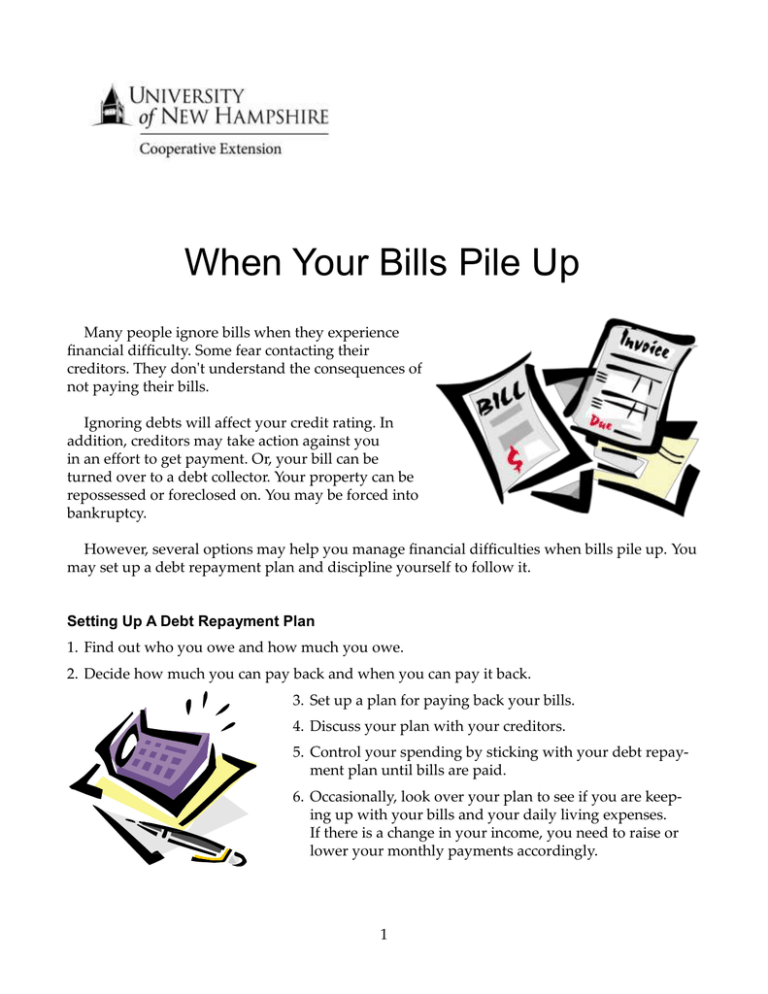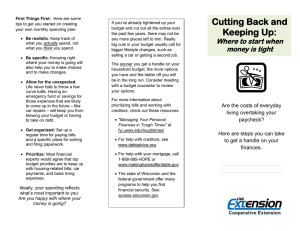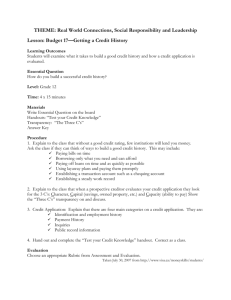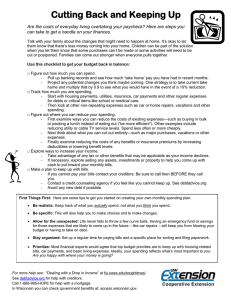When Your Bills Pile Up
advertisement

When Your Bills Pile Up Many people ignore bills when they experience financial difficulty. Some fear contacting their creditors. They don't understand the consequences of not paying their bills. Ignoring debts will affect your credit rating. In addition, creditors may take action against you in an effort to get payment. Or, your bill can be turned over to a debt collector. Your property can be repossessed or foreclosed on. You may be forced into bankruptcy. However, several options may help you manage financial difficulties when bills pile up. You may set up a debt repayment plan and discipline yourself to follow it. Setting Up A Debt Repayment Plan 1. Find out who you owe and how much you owe. 2. Decide how much you can pay back and when you can pay it back. 3. Set up a plan for paying back your bills. 4. Discuss your plan with your creditors. 5. Control your spending by sticking with your debt repayment plan until bills are paid. 6. Occasionally, look over your plan to see if you are keeping up with your bills and your daily living expenses. If there is a change in your income, you need to raise or lower your monthly payments accordingly. 1 The Amount Of Money Owed When you have more bills than you can handle, the first step is knowing who you owe and how much you owe. Organize your credit payments by using the "Credit Payment Chart" below. Creditors include financial institutions, credit card companies, utility companies plus any other company or person you owe money to. Collateral is an asset you pledged to back up a debt. This could be a car, a house, etc. APR is an annualized measure of a finance charge stated as a percentage. Monthly Payment is the amount due each month on an installment loan or the minimum due for revolving credit. Balance Due is the total amount you owe the creditor less interest (you may need to call the creditor for this information.) Credit Payment Chart List all of your credit agreements in the chart below. These will include installment loans (the same amount is paid each month) and revolving credit (the amount varies). If you need more room, copy the form on another piece of paper. Creditor Name, Address, Account # Collateral (if any) APR 1. 2. 3. 4. 5. 6. 7. 2 Monthly Payment Number of Remaining Payments Balance Due Decide How Much You Can Pay Back On a piece of paper list your monthly take-home income and total it. Next list the expenses for which you have to pay the same amount each month (i.e. mortgage/rent, car payment, etc.). Below these expenses, list the expenses that change (i.e. food, clothing, etc.). Think about the expenses that come periodically (i.e. car registrations, gifts for holidays, etc.). Determine the portion of each periodic expense that will be added as a monthly expense. Total your monthly expenses. Compare your monthly income with your monthly expenses. See if you can decrease some of your expenses so you will have more money to pay back your debts. Examine the expenses that change and the periodic expenses. These will be the easiest to adjust. Design a bare bones spending plan. This spending plan may not be how you would like to live the rest of your life, but for a short time until your debts are paid off it’s tolerable. Your goal is for your income to equal expenses and debt repayment. Decide on spending priorities for the upcoming months. If possible, raise some extra income but only after you have cut your expenses as far back as they can go. Put your credit cards aside and, if necessary, cut them up. If you would like further help developing a spending plan, request the publication “Developing A Spending/Savings Plan” from the UNH Cooperative Extension office nearest you. (Office locations and phone numbers are on page 8.) Set Up A Plan For Paying Back Your Bills Next, review your credit agreement(s) and develop a reasonable plan. There are a number of methods you can use to pay your bills. Five methods are listed below. Refer to the completed "Credit Payment Chart" (page 2), consider each method and decide which one(s) you will use to pay your bills. 1. "MOST IMPORTANT" METHOD. Pay those debts most important to your credit rating or to maintain your family ’s safety. For example, you need to pay for rent, food and utilities. Is there some item that can be repossessed or foreclosed on? You may need to make a payment on the car to keep it from being repossessed. (Cars tend to be repossessed more quickly than furniture and appliances, unless the furniture and appliance contract is recent and a large amount is owed.) Other debts may not be as important and a minimal payment may be all that needs to be made for a while. If you owe on store and/or bank credit cards, you should try to make some payment on them each month because these businesses typically report monthly to credit bureaus and nonpayment effects your credit rating. List your creditors that are most important. Refer to the Creditor column and the Collateral column on the "Credit Payment Chart" (page 2.) 3 2. "LOW BALANCE" METHOD. Pay off bills with the lowest balance due. For example, if you owe only 2 more payments on your car or refrigerator, you may want to pay those first. Then the money you used for those payments can go to pay off other debts. Which debts do you have that could be paid off in 2 or 3 months? Refer to the Number of Remaining Payments and the Balance Due columns on the "Credit Payment Chart" (page 2.) 3. "HIGH INTEREST" METHOD. Pay off those debts with the highest interest rate. Find out your interest rate by closely examining the monthly statement. Interest charges can be very costly. Paying off those debts with the highest interest rates can free more of your money to pay on other loans. List your debts that have the highest interest rates. Refer to the APR Column on the “Credit Payment Chart” (page 2.) 4. "NEW PAYMENT PLAN" METHOD. The general rule is that credit payments, not counting mortgage payments, should not exceed 15-20 percent of your take home pay. If they do exceed that amount, you could work with your creditors to set up a new payment plan for your debts. This idea works well with utility companies when you have high winter bills and lower summer bills. To set up a new plan, you need to know your monthly takehome income and your monthly bills total, minus mortgage or rent. Example Your Figures 1 Determine the amount you can pay for bills. If your take-home income is $800 per month, you can safely afford $160. 1 Determine the amount you can pay for bills. $ x .20 = $ Your monthly take-home income $800.00 X .20 (20%) = $160.00 Amount you can pay for bills 2 Determine the percentage you can pay toward each bill. Total your bills, excluding the mortgage or rent payment. If your bills total $210, you can pay 76% towards each bill. $160 $210 = .76 (76%) 2 Determine the percentage you can pay toward each bill. $ $ =. (%) 3 Multiply each bill amount by this percentage. This is what you would ask the creditor to accept each month. 3 Multiply each bill by the percentage in Step 2. This is what you would pay each month. Amount you can pay for bills Utility bill Telephone bill Utility bill $60.00 x .76 = $45.60 Telephone bill $40.00 x .76 = $30.40 Monthly bills total (excluding mortgage or rent) $ $ x. x. = $ = $ If you find you can pay more, make your payments as large as you can. Which creditors do you think you could talk to about a new payment plan? Refer to the Creditor Column on the "Credit Payment Chart" (page 2.) 4 5. "DEBT CONSOLIDATION" METHOD. You could get a loan to pay off all your debts. The payments on the consolidation loan would be less than your current payments because they are spread out over a longer period of time. Monthly payments will be lower, but in the end it will cost more because you will pay more interest. If you do this it’s important that you stop using your credit cards and don’t take out any other loans until all your debts are paid. Discuss Your Plan With Your Creditors Now that you’ve decided how you’re going to pay each of your bills, you’ll need to contact your creditors. They can be contacted in person, by telephone and by mail. In Person The best approach is to call and make an appointment to talk to the creditor in person. When you call, ask to speak to the person in charge of bill payment problems. Explain your situation briefly and ask if there are any records you need to bring. At the appointment, explain your situation and how long you expect your financial problems to last. Show sources of income and strategies for paying family expenses. Ask the creditor to reduce payments temporarily or let you pay only the interest, or extend the term of the loan. Emphasize that you want to work out a mutually acceptable plan. If your plan isn’t acceptable, ask what the creditor would suggest. If an agreement is reached with the creditor, write down the details. By Telephone When you contact a creditor by telephone, ask to speak to the person in charge of adjusting bill payments. The person who answers the phone often is not authorized to make payment changes. Wait to explain the details of your problem until you have reached a manager or supervisor. Explain the reasons you can’t pay your bill and how much you can pay now. If the creditor doesn’t accept your proposed payments, ask for specific suggestions of what to do. By working together the bill will get paid. Keep a record of each call including the date, with whom you talked and any arrangements made. By Mail When contacting a creditor by mail, write a letter stating the reason you are unable to pay the full bill. State the amount you are sending as partial payment and your plans for future payments. See sample letters on page 6. Type the letter or write neatly. Keep a copy of the letter for your records. You’ll need it when you receive a letter or call from the creditor responding to your proposed payments. The following sample letters may be helpful in preparing a letter. Change them as needed to fit your specific situation. Be truthful and specific about your situation (such as being laid off, having an accident, extended illness, reduced work hours, divorce, etc.) and how long you expect it to last. Don’t promise to do things which may not happen. 5 SAMPLE LETTER 1 (partial payment) Date Your Address Account # Name of Creditor Attention: Delinquent Account Representative Address City, State ZIP Code Dear Sir or Madam: Due to (list the reason for your financial problem), my income has decreased. I can not make the entire payment on the above account at this time. I have enclosed a reduced payment of . By carefully adjusting my budget, I expect to send a (weekly, monthly, quarterly) payment of $ . If these terms are not acceptable, please contact me to discuss another arrangement. I will not take on additional debt until I am restored to sound financial standing. I will increase my payment as soon as possible. I can be reached by telephone at between the hours of . Sincerely, Your Name SAMPLE LETTER 2 (unable to send a payment now) Date Your Address Account # Name of Creditor Attention: Delinquent Account Representative Address City, State ZIP Code Dear Sir or Madam: Due to (list the reason for your financial problem), my income has decreased. I can not make the payment on the above account. I have prepared a realistic, minimum budget for my living expenses and have developed a debt repayment program. I am asking each of my creditors to accept a reduced payment. I will send a (weekly, monthly, quarterly) payment of $ beginning (list date). If these terms are not acceptable, please contact me to discuss another arrangement. I will not take on additional debt until I am restored to sound financial standing. I will increase my payment as soon as possible. I can be reached by telephone at between the hours of Sincerely, Your Name 6 . After Contacting Creditors Remember, even after you have contacted your creditors, you still have the responsibility to pay your bills. Until you get back on your feet, don’t use any more credit. Try to keep up with the payments you have agreed to. Creditors will be less likely to give you a break the second time around. If you are unable to work out agreements with creditors that make your situation manageable, consider consulting a third party, such as Green Path Debt Solutions of New Hampshire and Vermont (800-327-6778 or 603-224-6593). Green Path Debt Solutions is a non-profit group that assists consumers in working out debt repayment plans. Counseling is a free service. The sliding fee scale for debt management services ranges from $5.00 per month to $50.00 per month. The average fee is $35.00 per month. After implementing your plan, keep track of the impact on your credit score by obtaining copies of your credit file and reviewing the report for errors. For more information on how to do this, request a free copy of Your Credit File from your county office or download a copy from our publications web site. Last Chance Efforts When all else has failed, filing for bankruptcy is the legal release from debts. Bankruptcy is based on the premise that we all make mistakes. It allows individuals an opportunity to start over again. Bankruptcy should not be considered as the easy way out but as a last resort. There are three bankruptcy choices for those who cannot repay their obligations: Chapter 7, Chapter 11, and Chapter 13. Bankruptcy stays on your credit history record for ten years and will negatively impact your future borrowing options. The Bankruptcy Abuse Prevention and Consumer Protection Act of 2005 requires people who plan to file for bankruptcy protection to get credit counseling from an approved organization within six months before they file. After filing, they must complete an approved debtor education class before their debts will be discharged. For more information, request or download a copy of Before You File for Personal Bankruptcy: Information About Credit Counseling and Debtor Education from the Federal Trade Commission or the US Trustee Program. Consumers are advised to obtain counseling services before contacting an attorney as bankruptcy may be able to be avoided. For a list of approved bankruptcy counseling or pre-discharge education programs, go to the Department of Justice US Trustee Program’s website. 7 Written by Suzann Enzian Knight, M.O.E., M.S., CFP, Extension Specialist Family Resource Management Acknowledgment The author acknowledges material adapted from Financial Fitness: Trim Your Credit Line, by Jeanne Hogarth, Ph.D., Cornell University Cooperative Extension, Taking Charge In Changing Times - Contacting Creditors, Oklahoma State University, Home Economics, Cooperative Extension Service and Getting Out of Debt by Mary J. Stephenson, Ph.D., CFP, CLU, Maryland Cooperative Extension Service. This publication was reviewed by Extension Educators, Barbara Hunter, Deborah Maes, Margaret Wilson, Associate Professor Elizabeth M. Dolan, Dept. of Family Studies, UNH and Pat Muzzey, Executive Director Consumer Credit Counseling Service of New Hampshire and Vermont. In addition to this publication, the University of New Hampshire Cooperative Extension conducts money management workshops for individuals and families. For more information contact the University of New Hampshire Cooperative Extension office nearest you. UNH Cooperative Extension County Offices BELKNAP 635 Main Street 3rd fl. Suite 1 Laconia, NH 03246-2900 (603) 527-5475 CARROLL 73 Main St. P.O. Box 1480 Conway, NH 03818 603-447-3834 CHESHIRE 800 Park Ave. Keene, NH 03431-1513 (603) 352-4550 COÖS 629A Main St. Lancaster, NH 03584-9612 (603) 788-4961 GRAFTON 3855 DCH, Box 5 North Haverhill, NH 03774 (603) 787-6944 HILLSBOROUGH 329 Mast Rd., Room 101 Goffstown, NH 03045-2418 (603) 641-6060 MERRIMACK 315 Daniel Webster Hwy Boscawen, NH 03303 (603) 796-2151 (603) 796-2151 SULLIVAN 24 Main Street Newport, NH 03773 (603) 863-9200 ROCKINGHAM 113 North Road Brentwood, NH 03833 (603) 679-5616 STRAFFORD 268 County Farm Road Dover, NH 03820 (603) 749-4445 "Helping You Put Knowledge And Research To Work" The University of New Hampshire Cooperative Extension is an equal opportunity educator and employer University of New Hampshire, U.S. Department of Agriculture and N. H. counties cooperating. 3/13 8


